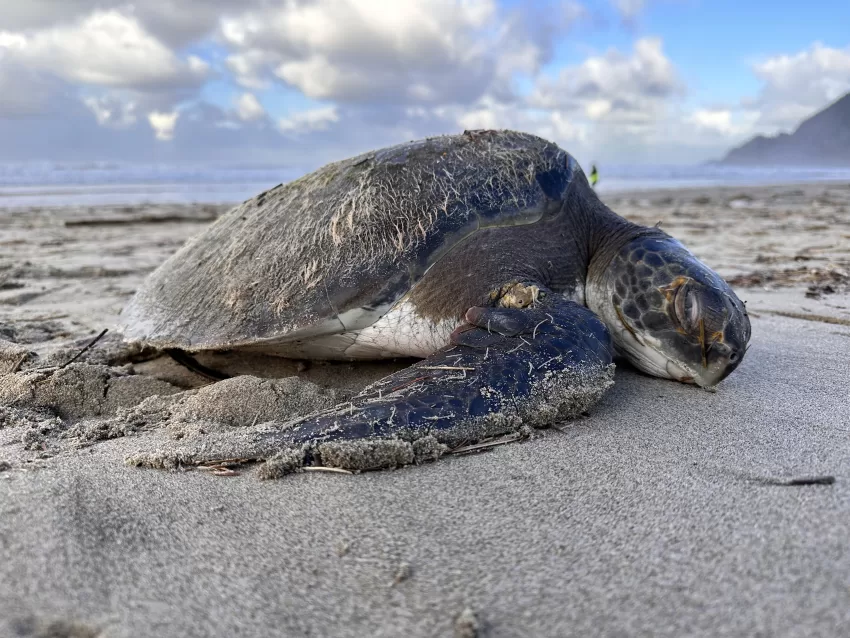Photos by Tiffany Boothe, Seaside Aquarium
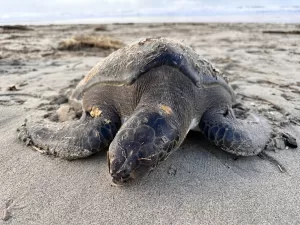
Seaside Aquarium was alerted of a live sea turtle on Manzanita Beach on Saturday morning January 6, 2024 at 8:30 a.m. Staff was able to get to the turtle in less than an hour (the Seaside Aquarium is located about 30 minutes north of Manzanita.)
The turtle was very lively and was identified as a green sea turtle. The 22 pound female was taken to the Seaside Aquarium before being transferred to the Oregon Coast Aquarium. There it will begin its rehabilitation. While we are optimistic about its recovery, the turtle still has a very long road ahead of her.
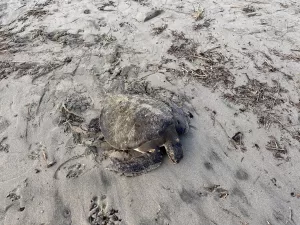 Green sea turtles can weigh up to 350 pounds and can live for over 70 years. According to NOAA, Green turtles are found worldwide primarily in subtropical and temperate regions of the Atlantic, Pacific, and Indian Oceans, and in the Mediterranean Sea.
Green sea turtles can weigh up to 350 pounds and can live for over 70 years. According to NOAA, Green turtles are found worldwide primarily in subtropical and temperate regions of the Atlantic, Pacific, and Indian Oceans, and in the Mediterranean Sea.
In U.S. Atlantic and Gulf of Mexico waters, green turtles are found in inshore and nearshore waters from Texas to Maine, the U.S. Virgin Islands, and Puerto Rico. Important feeding areas in Florida include the Indian River Lagoon, the Florida Keys, Florida Bay, the Dry Tortugas, Homosassa, Crystal River, Cedar Key, and St. Joseph Bay.
In the eastern North Pacific, green turtles have been sighted as far north as southern Alaska, but most commonly occur from southern California to northwestern Mexico. Elsewhere in the U.S. Pacific, green turtles occur in Hawaii, American Samoa, Guam, and the Commonwealth of the Northern Mariana Islands.
Green turtles occur in many countries, making it critical to work together for their protection and recovery.
Essentially, sea turtles forage for food in an offshore, warm water current. Weather conditions (such as a long, constant string of south-southwesterly winds) can drive the warm water current (and therefore the turtles) further north and closer to shore than normal. When the weather conditions suddenly change, the warm waters quickly dissipate and the turtles find themselves trapped in the colder waters of the natural currents running along the Oregon and Washington Coasts. When this happens, their bodies slow down and they become hypothermic. Those that can make it to shore ‘haul’ out to get out of the cold water, but the winter conditions on the beach are rarely more hospitable.
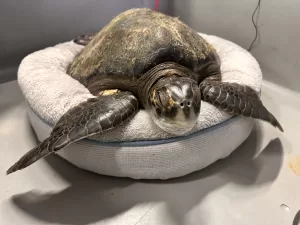
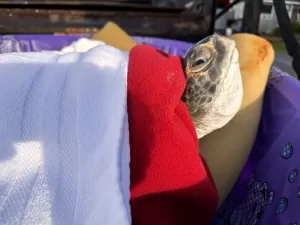 When found on the beach, it can be difficult to determine if a sea turtle is dead or alive. A turtle suffering from extreme hypothermia can be unresponsive to touch and have a heartbeat so slow and weak that it is difficult to detect. Most sea turtles found on Oregon and Washington shores do not survive, even if found and recovered quickly. Those that do live are taken to one of two licensed rehab facilities on the Northwest Coast — the Oregon Coast Aquarium or the Seattle Aquarium. When stabilized (which, if successful, can take up to a few weeks), the turtle is transferred to a center in California, where it will be released back into the wild.
When found on the beach, it can be difficult to determine if a sea turtle is dead or alive. A turtle suffering from extreme hypothermia can be unresponsive to touch and have a heartbeat so slow and weak that it is difficult to detect. Most sea turtles found on Oregon and Washington shores do not survive, even if found and recovered quickly. Those that do live are taken to one of two licensed rehab facilities on the Northwest Coast — the Oregon Coast Aquarium or the Seattle Aquarium. When stabilized (which, if successful, can take up to a few weeks), the turtle is transferred to a center in California, where it will be released back into the wild.
The Marine Mammal Stranding Network responds to sightings of turtles and other injured or dead marine mammals. For our region in northern Oregon, Seaside Aquarium is the local responder for the Marine Mammal Stranding Network and can be contacted at 503.738.6211. If a stranded mammal is found elsewhere, the Oregon State Police reporting line can be called 1.800.452.7888.

